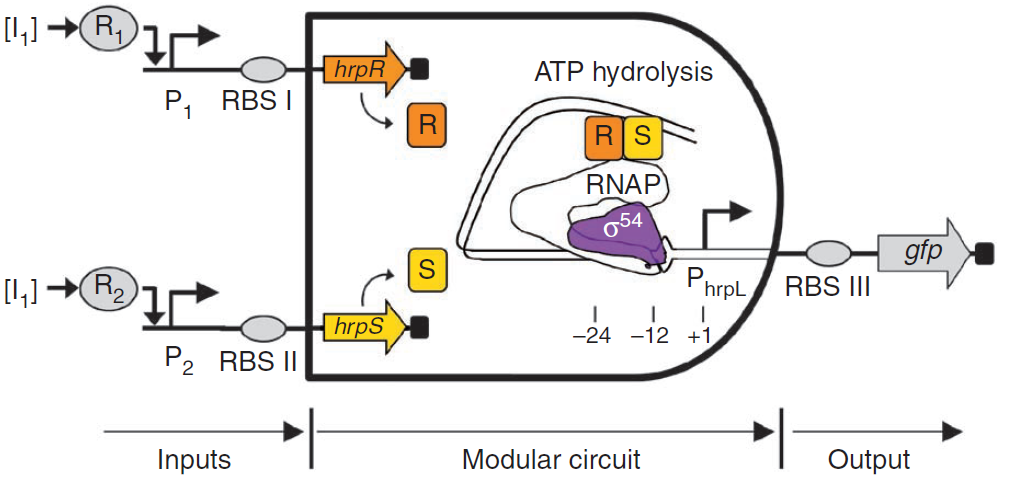Scientists create modular logic gates from bacteria and DNA
October 19, 2011

Biological AND gate built in an E-coli bacterium. Two environment-responsive promoters, P1 and P2, act as the inputs to drive the transcriptions of hrpR and hrpS genes, and respond to the small molecules I1 and I2, respectively. The transcription of the output hrpL promoter is turned on only when both proteins HrpR and HrpS are present and bind the upstream activator sequence to remodel the closed σ54-RNAP-hrpL transcription complex to an open one through ATP hydrolysis. The output shown is a gfp reporter gene. (Credit: Imperial College London)
Imperial College London researchers have demonstrated that they can build AND, NOT, and NAND digital logic gates out of E-coli bacteria and DNA, which could lead to a new generation of biological computing devices that, for example, swim inside arteries, detecting the buildup of harmful plaque and rapidly deliver medications to the affected zone.
The scientists constructed an AND gate from E.Coli bacteria and altered the E.Coli with modified DNA, which reprogrammed it to perform the same switching on and off process as its electronic equivalent when stimulated by chemicals. (AND gates only generate an output signal if all inputs are present.)
“We hope that our work could lead to a new generation of biological processors, whose applications in information processing could be as important as their electronic equivalents,” says Professor Richard Kitney, co-author of the paper from the Centre for Synthetic Biology and Innovation and the Department of Bioengineering at Imperial College London. The devices could detect and destroy cancer cells inside the body and detect and neutralize dangerous toxins such as arsenic in the environment.
Multiple-input genetic logic gates would allow cells to recognize complex conditions, based on a combination of several signals (for example, pH, temperature, small molecules or metal ions), and thus can greatly improve the sensing specificity and increase the accuracy of biological control, the researchers say in their paper. “For example, various environmental pollutant-like arsenic5, xylene6 and Pseudomonas aeruginosa-responsive7 sensors can be wired to a multiple-input AND gate, allowing cells to report and neutralize a combinatorial toxic circumstance.
“The AND gate inputs can also be connected to certain disease-related signal responsive promoters and the output to a therapeutic gene to achieve highly specific in vivo targeting and curing of diseased cells. Furthermore, multiple logic gates can be combined to build larger information-processing circuits with advanced cellular functions, such as a projected image edge detector and even a cellular event counter.”
The advantage of these biological logic gates over previous attempts is that they behave more like their electronic counterparts, and are modular (they can be fitted together to make different types of logic gates), paving the way for more complex biological processors to be built in the future, the researchers say. Also, unlike electronic digital circuits, the components in a biological circuit are not connected by wires, and the flow of biological information has to depend on their specific chemical interactions to avoid cross-talk with the host genetic programs.
Forming complex circuitry

NAND gate (credit: Imperial College London)
The researchers were also able to demonstrate that the biological logic gates could be connected together to form more complex components in a similar way that electronic components are made. In another experiment, the researchers created a NOT gate (inverter) and combined it with the AND gate to produce the more complex NAND (not and) gate. (All other types of Boolean logic gates can be constructed from NAND gates.)
The next stage of the research will see the team trying to develop more complex circuitry that comprises multiple logic gates. One of the challenges faced by the team is finding a way to link multiple biological logic gates together, similar to the way in which electronic logic gates are linked together, to enable complex processing.
Ref.: Baojun Wang, et al., Engineering modular orthogonal genetic logic gates for robust digital-like synthetic biology, Nature Communications, 18 October 2011; [DOI:10.1038/ncomms1516]